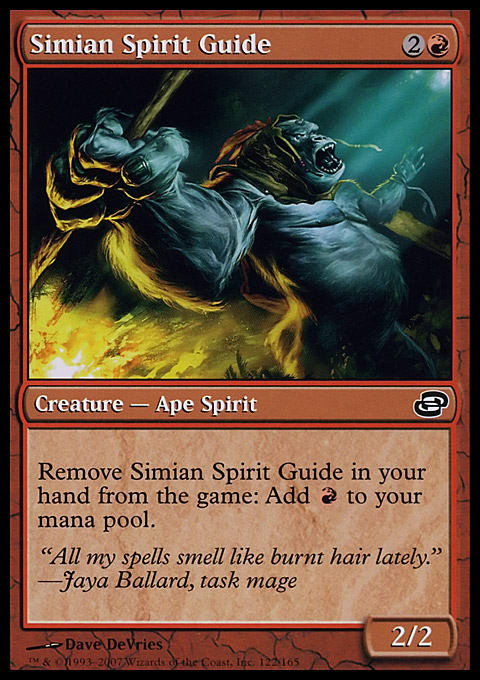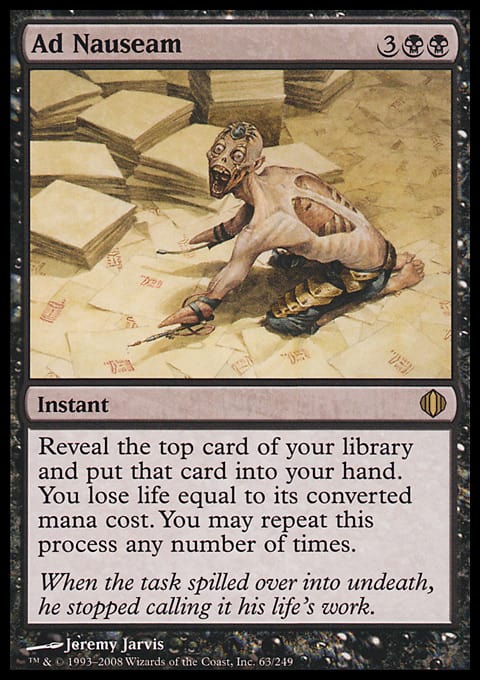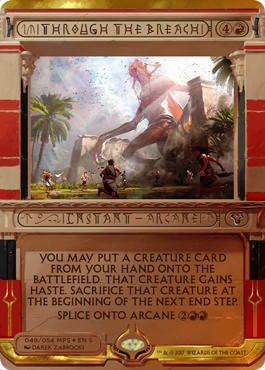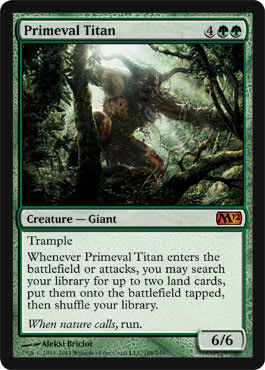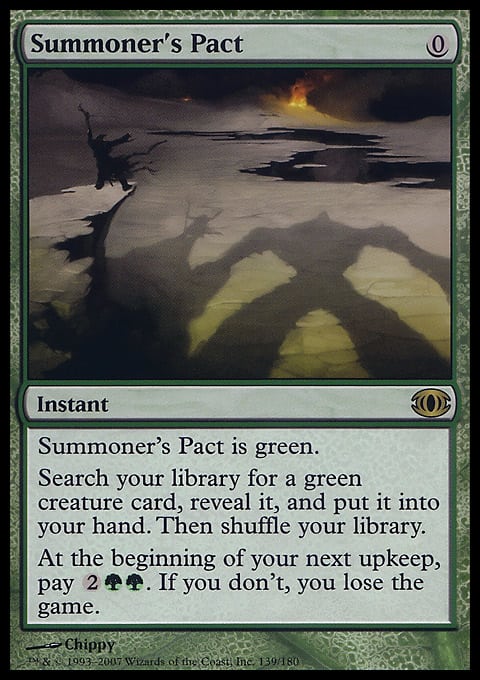As my good friend Shaheen Soorani, noted control aficionado, likes to put it, some players just love playing “chuckler decks”. I’ve heard them called “chimp decks”, “monkey decks”, “donkey decks”, and some less PG-rated names, but the fact stands that a small subsection of Magic strategies are generally demeaned as low-skill and low-interaction. Longtime players often look down on these strategies, as when they work, the game frequently ends with the opponent looking helpless, and when they don’t, the game ends with the player themselves looking helpless. Often, decks like these are high-variance, with powerful openings that win the game as early as turn one, but with high proportions of hands that do nothing or fall apart to a single piece of interaction.
Of course, it could just be that a lot of the time, a “chimp deck” includes some number of the best Ape in Magic, Simian Spirit Guide. Appropriate, perhaps, that Wizards of the Coast printed an Ape Spirit that goes well with strategies so simple an orangutan could pilot them to victory. The next time your opponent leads off with a Simian Spirit Guide into a turn-one Chalice of the Void, feel free to do your best chimpanzee impression, as there’s a decent chance that’s the only interaction you’ll be able to muster all match!
Now, for the longest time, I (like many other players) avoided these sorts of crapshoot decks like the plague. Though they give the pilot a decent chance to spike a tournament, they offer little in the way of gameplay and fail to maximize player skill to any degree. However, maximizing player skill is only one of the reasons to play a deck, and the conditions in Modern and Standard are ripe right now for a couple of cheeky monkeys to win the SCG Invitational this weekend.
In Modern, of course, there are a number of factors at play when it comes to choosing a deck. The three overarching themes a player must consider when selecting a strategy for a tournament (assuming card availability is not an issue) are:
1. Overall Power Level
This is where your Affinity, your Dredge, your Ad Nauseam, your Infect, and your Grishoalbrand decks soar, and your Bant Eldrazi, your Abzan Midrange, your Jeskai Control, and your Merfolk decks sink. Overall, there is a huge edge for linear, powerful decks that execute their game plan and often overwhelm the opponent before their deck even sets up. In Modern, players should generally hedge toward raw power assuming all other factors are equal. Hell, Mani Davoudi spotted a moment in the Modern metagame where Affinity hate was in a small lull, and took advantage of that lull to crush Grand Prix Las Vegas. I took an under-represented (and disrespected) Dredge deck to the finals of a recent Open, and with the correct metagame read, opportunities to do the same crop up from time to time in Modern. Treat this theme as the gut check for a gap in the Modern metagame for a powerful linear deck to destroy an unsuspecting tournament, and plan accordingly. Of course, if it were only about overall power, we’d never see any of the lower-power decks do well, but for every Affinity win we see a Jund or Abzan deck succeed as well. What gives?
2. Is this deck targeted by hate? Or can it target the popular decks with hate of its own?
Maindeck Relic of Progenitus in Eldrazi Tron. Sideboard Leyline of the Void in Jund. Nihil Spellbombs, By Forces, Ceremonious Rejections, and Collective Brutalities in Grixis Death's Shadow. Rest in Peace and Stony Silence in Hate Bears decks. Fulminator Mage, Crumble to Dust, Ancient Grudge, Slaughter Games, Grafdigger's Cage, Anger of the Gods, Timely Reinforcements! The list goes on and on, and it doesn’t matter how powerful your linear deck is if the metagame is prepared to beat it. By carefully balancing precious sideboard slots, a savvy player can shore up sufficient percentage against all the expected enemies to grant themselves moderately favorable matchups all around. If the metagame is in such a position to allow this exploit, a midrange deck will often rise to the top, as seen by the rise of Death's Shadow Jund, Abzan Midrange, and the like earlier this year. Of course, the smart players will find the linear that these midrange decks were skimping on hating out, and drive a truck through that metagame hole. (Again, the recent success of Affinity and Dredge prove that point.)
Part of the issue with Modern, of course, is that many players are not finely attuned to every subtle shift in the metagame, and as such the third important theme of deck selection rears its ugly head.
3. Consistency and Comfort
If you’ve been playing Jund ever since Modern came into being six years ago, chances are you know how to ride the waves of the metagame, how to handle just about every one of the 50+ decks you might face, and how to tweak your sideboard for the hot deck of the moment. A prime example of this is Reid Duke. Reid, whenever he finds himself at a loss for what to play in Modern, often dials it back to old-school Jund, and recently took that outdated deck to a Top 4 finish at the Open in Baltimore. Is Reid a great player? Of course. Is Jund a top-tier deck? No way! Can a strong player win on any given Sunday (or Saturday) with a deck they know in and out, despite poor metagame positioning? Unquestionably. Consistency and comfort are the intangibles, the factors that lead a player to take a deck that might be a worse choice on raw win percentages and win with it despite that handicap. Because people will often play the same decks week in and week out, there is a huge reward for playing a deck you know well, especially if the alternatives are non-intuitive, complex, and likely to lead you to make a few unsightly punts.
Of course, this would all be true, unless the alternative is . . . a deck built for chimpanzees. It’s not pretty, it’s not finely tuned, it’s not even the best linear, not by a long shot. But ![]()
![]() Valakut Breach is the chimp deck to play this weekend, with a stellar metagame position and a high raw power level. Let’s get into why.
Valakut Breach is the chimp deck to play this weekend, with a stellar metagame position and a high raw power level. Let’s get into why.
Last week, we saw Eldrazi Tron, Grixis Death's Shadow, a handful of middling creature decks, and Affinity do well. Valakut Breach is the only combo deck that doesn’t roll over and die to Shadow’s heavy discard (as you are always drawing live to a big Primeval Titan or Summoner's Pact for Titan) while presenting a consistent turn-four goldfish. If Eldrazi Tron is a big-mana deck with super-live topdecks that reduce the effectiveness of Death's Shadow’s heavy discard, Valakut Breach is similarly powerful at topdecking while also mauling Eldrazi Tron itself. Similarly, Valakut Breach can goldfish Affinity, can board multiple Ancient Grudges, especially compared with many Eldrazi Tron draws that fall apart to the robot army.
Valakut Breach basically falls into the same metagame spot as Eldrazi Tron, with many similar matchups, but it exchanges a slightly worse Grixis Shadow matchup (and I emphasize that word here, as it’s not even clear-cut that it’s actually worse) for a humongous edge against a number of challenging matchups for Eldrazi Tron, and a great matchup against Eldrazi Tron. In this specific situation (barring a metagame adjustment with more hate for the Valakut endgame) Valakut Breach has eclipsed Eldrazi Tron as the best big-mana deck of choice, leaving this erstwhile Eldrazi Tron player little choice but to consider joining the chorus of chimps churning out turn-four Titans.
With Dredge hate remaining relatively high (including the massive pile of graveyard hate from Eldrazi Tron) and Affinity hate on the upswing (as Mani Davoudi did just win the GP with it) the highest-power yet least-targeted deck to play this weekend is Valakut Breach. Even more to its credit, Valakut Breach barely missed the Top 8 of GP Las Vegas on tiebreakers, keeping it under the radar while alerting knowledgeable players to a possible powerhouse.
Zach Voss’ 9th place list is no-nonsense, with a few spicy sideboard cards that seem tremendous right now.
R/G Valakut Breach ? Modern | Zach Voss
- Creatures (13)
- 1 Woodfall Primus
- 4 Primeval Titan
- 4 Sakura-Tribe Elder
- 4 Simian Spirit Guide
- Planeswalkers (2)
- 2 Chandra, Torch of Defiance
- Instants (8)
- 4 Summoner's Pact
- 4 Through the Breach
- Sorceries (12)
- 1 Scapeshift
- 3 Anger of the Gods
- 4 Farseek
- 4 Search for Tomorrow
- Lands (25)
- 2 Forest
- 6 Mountain
- 1 Bloodstained Mire
- 2 Cinder Glade
- 2 Windswept Heath
- 4 Stomping Ground
- 4 Valakut, the Molten Pinnacle
- 4 Wooded Foothills
- Sideboard (15)
- 4 Chalice of the Void
- 1 Pithing Needle
- 2 Ancient Grudge
- 2 Sudden Shock
- 2 Ensnaring Bridge
- 1 Reclamation Sage
- 1 Chameleon Colossus
- 2 Obstinate Baloth
Chimp alert! Chimp alert! Simian Spirit Guide is churning out Titans too early!
Think about the following sequence: turn one, suspend Search for Tomorrow. Turn two, cast a Farseek getting a Stomping Ground. Turn three, unsuspend Search, play a land, exile a Spirit Guide, cast a Primeval Titan. Or hell, you don’t even need the Spirit Guide, just Through the Breach a Titan and smash your opponent out of nowhere! If this isn’t the Modern answer to Legacy’s Mono-Red Sneak Attack, I don’t know what is.
Beyond the nut-draw potential of the deck, there is also the small matter of the topdeck potential when facing down a Death's Shadow opponent. With ten or more live topdecks every turn that result in a win (four Primeval Titans, four Summoner's Pacts, one Scapeshift, possibly Chandra or Woodfall Primus, or Chameleon Colossus after sideboard) you have about a 20% chance of just killing them every turn they don’t kill you. From my end, a few more Chameleon Colossi or even Tireless Trackers in the sideboard would be welcome to help liven up your topdecks against the Grixis menace. The only trouble with this deck is a total lack of interaction with the sorts of decks that out-goldfish you! Like Eldrazi Tron, Valakut Breach is heavily unfavored against decks like Ad Nauseam, and without significant graveyard hate it is worse against Storm and Grishoalbrand. However, assuming those decks won’t show up in force, Valakut Breach is as good or better than Eldrazi Tron against a wide swath of the metagame. Of the three themes of deck selection, Valakut Breach knocks it out of the park with metagame positioning, has a decently high power level, with low interaction but high resilience to traditional forms of interaction, and answers the “comfort” question with a big old monkey laugh. Its consistency leaves something to be desired, but it is not meaningfully less consistent than a majority of the combo decks of Modern. Truly, for this weekend, there’s no higher-percentage choice.
Please join me next week for a video series with Valakut Breach, hopefully on the heels of a strong Invitational finish!
Before that, though, there is a small matter of the most important honor that can be bestowed on a competitive Magic player. That’s right, the Hall of Fame voting process has begun again for the class of 2017, and there are a few stellar candidates. One factor that gets less press than it should is “longevity and dedication to the game”. For a few Pro Tour players, they knock it out of the park once or twice, but fail the persistence test and drop off the Tour after a year or two of Platinum. Other players are the opposite, grinding year after year before making the big breakthrough finish (ahem, Calcano). On this ballot, I paid special attention to two players with immense reserves of grit and dedication, players who have stayed on the Tour for nearly a decade with solid results and the respect of their fellow pros (myself included). Those two players, with slightly weaker resumes than might otherwise merit inclusion in the Hall, get my vote because of their passion and “stick-to-it-iveness”. They are Craig Wescoe and Martin Juza, and they join Mark Herberholz, Chris Pikula, and the slam-dunk Josh Utter-Leyton as my bids for the 2017 Hall of Fame.
Though it’s unlikely that this year will see all five of these men inducted into the Hall, my hope is that my recognition of their longevity will help them push themselves to get those few extra strong finishes and make an even stronger case next year. Hats off to all the candidates, as even being on the ballot for the Hall of Fame is worth celebrating!
That reminds me, I’m probably about four Top 8’s and a PT win short of my own Hall of Fame spot. Better get back to the grind!
—Ben













